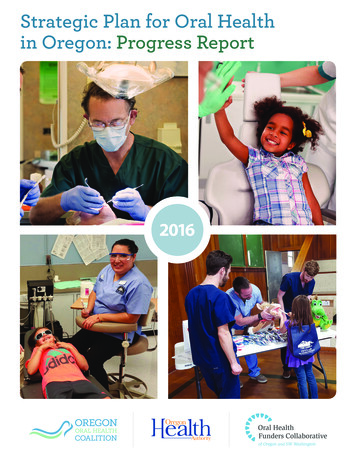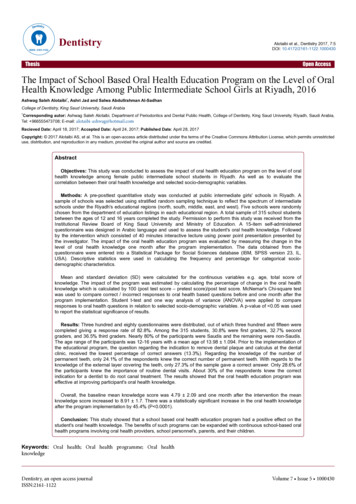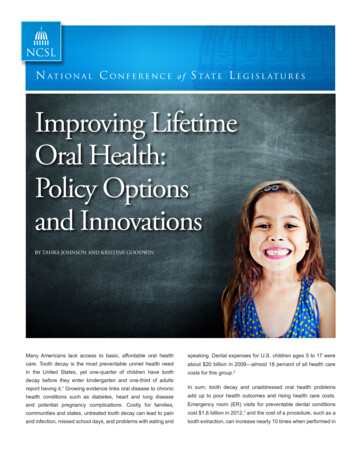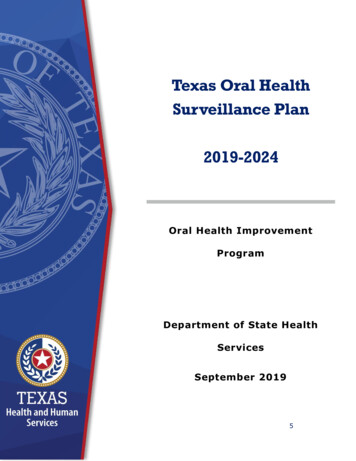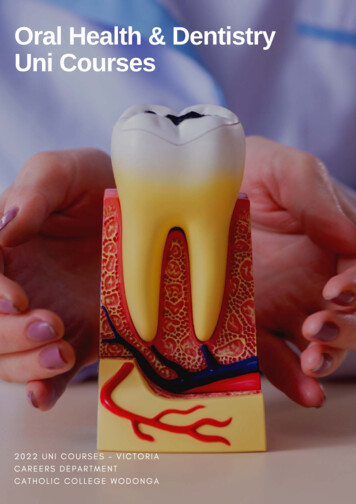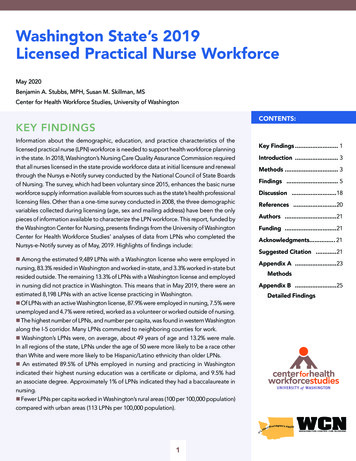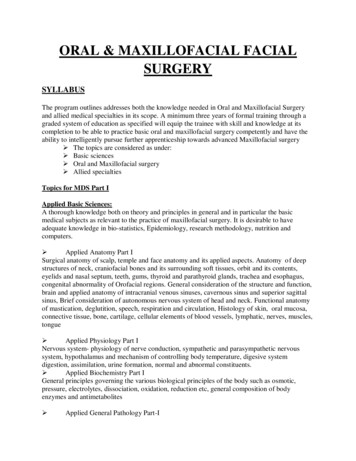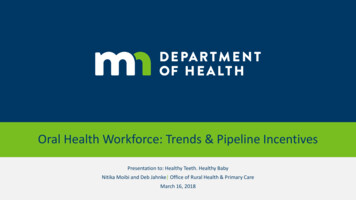
Transcription
Oral Health Workforce: Trends & Pipeline IncentivesPresentation to: Healthy Teeth. Healthy BabyNitika Moibi and Deb Jahnke Office of Rural Health & Primary CareMarch 16, 2018
Oral health workforce6/5/2018Source: Board of Dentistry, December 2013. Includes all professionals who have an active license and report practicing in Minnesota (“Active Practice In State.”N 12,961). Of these, 5,819 were dental assistants; 4,101 were dental hygienists; 3,013 were dentists, and 27 were dental therapists2
Top 10 healthiest Counties(in order): Carver, Scott, Washington, Dodge, Stevens, Nicollet, Lacqui Parle, Fillmore, Red Lake and Wright.What does this mean for oral health access?Carver County - 42 dentistsScott County - 53 dentists32 counties 5 dentists6/5/2018Source: 2018 County Health Rankings report released by RWJF & University of Wisconsin PopulationHealth Institutehttp://www.countyhealthrankings.org/ Note: The rankings are based on more than 30 factors thatinfluence health, including smoking, alcohol and drug use, obesity, teen births, high school graduationrates, income inequality, access to health care, and air and water quality.3Dentist counts are based on MDH analysis of data from Minnesota Board of Dentistry. IncludesDentists who are Active in 2015.
Understanding oral health (in)accessDental Health Professional Shortage Area(HPSA)65 Dental HPSAs in 54 counties- Mostly Low Income Population HPSAsPlus “some” Dental Facility HPSAs6/5/20184
Understanding oral health (in)accessGeographic Dental HPSAs Approved geographic service area Counting all population within the service area Ratio to all clinical dentists by FTE, ratio must be / 5000:1 Inaccessibility to Nearest Source of CarePopulation Dental HPSAs (i.e. Low-Income) Approved geographic service area Counting only population subset within the service area Ratio to clinical dentists FTE serving the population subset, ratio must be / 4000:1 Inaccessibility to Nearest Source of Care5
Understanding oral health (in)accessFacility HPSAs Automatic Facility HPSAs (not all provide dental services) Correctional Facility HPSAs Other Facility HPSAs, aka OFACs Free-standing outpatient dental clinic Located within proximity of Geo or Pop HPSA or serving HPSA population Demonstrate Insufficient Capacity (excessive visits or waiting time)6
Understanding oral health (in)accessPopulation-to-dentist ratio by rural-urban regions“How often do physicians provide care that a differentspecialist might otherwise provide if they wereavailable/accessible?”(Rural physicians only, 2016)Type of CareFrequency of filling gap incareOral Health*(N 167)NeverOccasionallyFrequentlyAll the time15.6%64.5%8.1%1.6%7
What does access truly mean?Access “goodness of fit”between providerand patientAccess MeasureMeaningIn MNAffordabilityExtent to which provider’s chargesrelate to willingness to pay by patientDental insurance coverage limited IF offered; selfpay/OOP costs highAvailabilityProvider has the requisite resources,such as personnel and technologyUnknownAccessibilityGeographic-128 dental HPSAs-High population to dentist ratio by RUCAAccommodationExtent to which the provider’soperation is organized in ways thatmeet the constraints and preferences ofpatient-Dentists median hours worked (34) physicianmedian hours worked (50)-Common for private practices to close onFridays/weekends/no evening hoursAcceptabilityExtent to which patient is comfortablewith the more immutablecharacteristics of the provider and viceversaUnknown-92% of dentists identify as White/Caucasian vs.19% MN residents identify as POC-Asians are fastest growing group (likely immigrantswith acute & unmet oral health needs; culturalbeliefs about US healthcare system)(Penchansky and Thomas 1981)8
Trends Aging population with comorbidities & complex needs Mouth is part of the body. Yet oral & medical divide remains in delivery, insurance Dental workforce: Overwhelmingly white, non-Hispanic, aging Rural dentists are among the oldest 1,000 licensed dentist are either practicing out of state or not practicing in MN - can they be incentivized to practice in MN? Younger cohorts of dental students are female – labor market implications 46% of male dentists work in their own solo practice compared to 26% female dentists Younger dentists want to practice in small or large group private practices instead of solo practices. Gen X/Y attributes & attitudes 1 out of 3 DTs is employed in a non profit clinic Dental providers not working at the top of their license, education, training Under utilization of expanded function dental assistants & collaborative practice hygienists Still some resistance to dental therapists despite successful track record of opening up access, meeting needs safely, providing quality care in a cost effective manner Maldistribution - regional differences9
Minnesota Statute 144.1481The Rural Health AdvisoryCommittee (RHAC) wascreated as part of Minnesota'slandmark 1992 health reformlegislation.The commissioner of healthshall establish a 15-memberRural Health AdvisoryCommittee, appointed by theGovernor.The committee shall consist ofthe following members, all ofwhom must reside outsidethe seven-countymetropolitan area. Legislators: Two members from the MN House and Senate fromboth majority and minority parties. Health care representatives Volunteer member of an ambulance serviceHospital representativeNursing home representativeMedical doctor or doctor of osteopathyMidlevel practitionerRegistered nurse or licensed practical nurseLicensed health care professional from an occupation nototherwise represented Higher education representative, from program that trains ruralhealth providers. Three consumers, at least one of whom is an advocate for personswho are mentally ill or disabled.10
RHAC Oral Health Project: Three overall recommendationsExpand andmaximize therural oral healthworkforceReform paymentto increaseaccess anddecreaseavoidable costsDevelop newmodels of ruraloral healthdeliveryA strongerrural oralhealthsystem11
Recommendation Set 1Increase reimbursement and types of servicescovered by MN Health Care Programs (MHCP)Simplify MHCP administrative processes1.REFORM PAYMENT TOINCREASE ACCESS ANDDECREASE AVOIDABLE COSTSInvest in expanded pediatric prevention andtreatment servicesPosition rural oral health providers foralternative payment models12
Recommendation Set 2Develop an online service to "match" ruraldental practices and professionalsEncourage greater use of Collaborative DentalHygienists2.EXPAND AND MAXIMIZETHE RURAL ORAL HEALTHWORKFORCEExpand understanding of how Dental Therapistscan add to a dental team13
Recommendation Set 3Develop rural center(s) for training and testingof new modelsPilot hub-and-spoke or other multi-site /regional models3. DEVELOP NEWMODELS OF RURALORAL HEALTH DELIVERYExpand use of portable systems andteledentistryEncourage Critical Access Hospitals to opendental units14
Workforce and Grant programs Loan Forgiveness/Loan Repayment/Scholarship (direct benefit to clinician) Community Clinic Grant Program Dental Safety Net Grant Program Clinical Dental Education Innovations Grant Program15
Loan Forgiveness and Loan Repayment MN Dentist Loan Forgiveness and MN DT/ADT Loan Forgiveness Contact: Brenda Flattum Brenda.Flattum@state.mn.us, 651-201-3870 MN State Loan Repayment Program Contact: Deb Jahnke Debra.Jahnke@state.mn.us, 651-201-3845 National Health Service Corps – Loan Repayment, S2S, Scholarship Contact: https://nhsc.hrsa.gov or Deb Jahnke for technical assistance16
MDH Grant Programs Community Clinic Grant Program Public or non-profit clinic that ensures access regardless of ability to pay Dental Safety Net Program Non-profit Critical Access Dental providers serving uninsured low-income, aged 21-under Clinical Dental Education Innovations Grant Program Affiliated with training program for dentists, therapists, hygienists and/or /funding/index.html17
Thank you!Nitika Moibi: Nitika.Moibi@state.mn.usDeb Jahnke: Debra.jahnke@state.mn.us18
Scott County - 53 dentists 32 counties 5 dentists . -92% of dentists identify as White/Caucasian vs. 19% MN residents identify as POC-Asians are fastest growing group (likely immigrants . Mouth is part of the body. Yet oral & medical divide remains in delivery, insurance Dental workforce: Overwhelmingly white, non-Hispanic, aging
